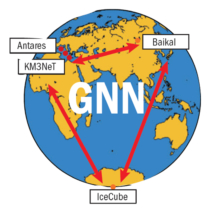
On 20–12 September, CERN hosted the fifth annual Mediterranean-Antarctic Neutrino Telescope Symposium (MANTS). For the first time, the meeting was organized under the GNN umbrella.
The idea to link more closely the various neutrino telescope projects under both water and ice has been a topic for discussion in the international community of high-energy neutrino astrophysicists for several years. On 15 October 2013, representatives of the ANTARES, BAIKAL, IceCube and KM3NeT collaborations signed a memorandum of understanding for co-operation within a Global Neutrino Network (GNN). GNN aims for extended inter-collaboration exchanges, more coherent strategy planning and exploitation of the resulting synergistic effects.
No doubt, the evidence for extraterrestrial neutrinos recently reported by IceCube at the South Pole (“Cosmic neutrinos and more: IceCube’s first three years”) has given wings to GNN, and is encouraging the KM3NeT (in the Mediterranean Sea) and GVD (Lake Baikal) collaborations in their efforts to achieve appropriate funding to build northern-hemisphere cubic-kilometre detectors. IceCube is also working towards an extension of its present configuration.
One focus of the MANTS meeting was, naturally, on the most recent results from IceCube and ANTARES, and their relevance for future projects. The initial configurations of KM3NeT (with three to four times the sensitivity of ANTARES) and GVD (with sensitivity similar to ANTARES) could provide additional information on the characteristics of the IceCube signals, first because they look at a complementary part of the sky, and second because water has optical properties that are different from ice. Cross-checks with different systematics are of the highest importance for these detectors in natural media. As an example, KM3NeT will measure down-going muons from cosmic-ray interactions in the atmosphere with superb precision. This could help in determining more precisely the flux of atmospheric neutrinos co-generated with those muons, in particular those from the decay of charmed mesons, which are expected to have particularly high energies and therefore could mimic an extraterrestrial signal.
A large part of the meeting was devoted to finding the best “figures of merit” characterizing the physics capabilities of the detectors. These not only allow comparison of the different projects, but also provide an important tool to optimize future detector configurations. The latter also concerns the two sub-projects that aim to determine the neutrino mass hierarchy using atmospheric neutrinos. These are both small, high-density versions of the huge kilometre-scale arrays: PINGU at the South Pole and ORCA in the Mediterranean Sea. In this effort a particularly close co-operation has emerged during the past year, down to technical details.
Combining data from different detectors is another aspect of GNN. A recent common analysis of IceCube and ANTARES sky maps has provided the best sensitivity ever for point sources in certain regions of the sky, and will be published soon. Further goals of GNN include the co-ordination of alert and multimessenger policies, exchange and mutual checks of software, creation of a common software pool, development of standards for data representation, cross-checks of results with different systematics, and the organization of schools and other forums for exchanging expertise and experts. Mutual representation in the experiments’ science advisory committees is another way to promote close contact and mutual understanding.
Contingent upon availability of funding, the mid 2020s could see one Global Neutrino Observatory, with instrumented volumes of 5–8 km3 in each hemisphere. This would, finally, fully raise the curtain just lifted by IceCube, and provide a rich view on the high-energy neutrino sky.





